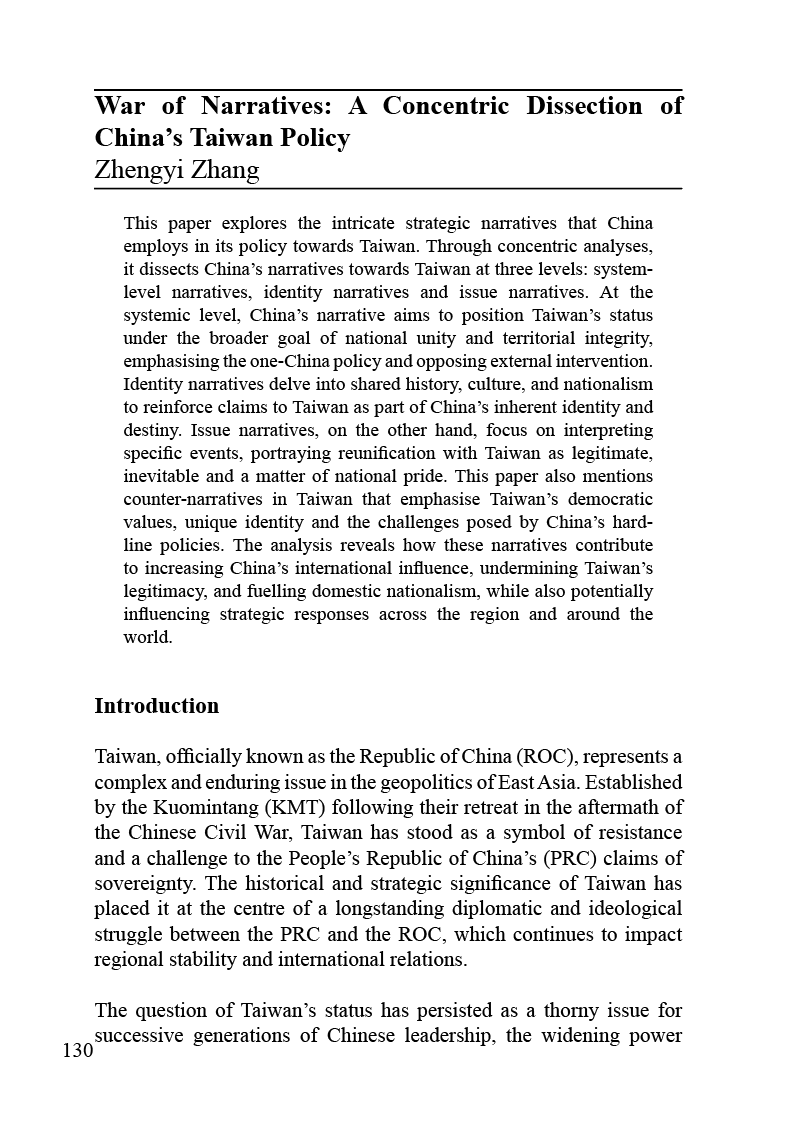War of Narratives
A Concentric Dissection of China’s Taiwan Policy
DOI:
https://doi.org/10.36399/GroundingsUG.15.121Keywords:
Taiwan, China, Political Narratives, International Relations, AsiaAbstract
This paper explores the intricate strategic narratives that China employs in its policy towards Taiwan. Through concentric analyses, it dissects China’s narratives towards Taiwan at three levels: system-level narratives, identity narratives and issue narratives. At the systemic level, China’s narrative aims to position Taiwan’s status under the broader goal of national unity and territorial integrity, emphasising the one-China policy and opposing external intervention. Identity narratives delve into shared history, culture, and nationalism to reinforce claims to Taiwan as part of China’s inherent identity and destiny. Issue narratives, on the other hand, focus on interpreting specific events, portraying reunification with Taiwan as legitimate, inevitable and a matter of national pride. This paper also mentions counter-narratives in Taiwan that emphasise Taiwan’s democratic values, unique identity and the challenges posed by China’s hard-line policies. The analysis reveals how these narratives contribute to increasing China’s international influence, undermining Taiwan’s legitimacy, and fuelling domestic nationalism, while also potentially influencing strategic responses across the region and around the world.
References
Bush, Richard C. Untying the Knot: Making Peace in the Taiwan Strait. Washington, D.C: Brookings Institution Press, 2005.
Buzan, Barry, and Ole Wæver. Regions and Powers: The Structure of International Security. Cambridge Studies in International Relations. Cambridge: Cambridge University Press, 2003.
Consulate General of PRC in Busan. “Taiwan has been part of China since ancient times.”, 2010. accessed 30 Dec 2023, http://busan.china-consulate.gov.cn/zt/zgtw/201004/t20100428_5781266.htm.
Dong, Xing. “First pineapples, now sugar apples”. Taiwan threatens to take China to WTO over new fruit import ban. ABC News, 2021 accessed 5 Jan 2024, https://www.abc.net.au/news/2021-09-21/china-taiwan-fruit-ban-may-jeopardise-application/100479612.
Freedman, Lawrence. “Strategic Communication.” Adelphi Paper 45, (no. 379, 2006), 73-93.
Jan, Chong Ja. “The Many “One Chinas”: Multiple Approaches to Taiwan and China.” Carnegie China (2023). accessed Jan 5, 2024. https://carnegieendowment.org/2023/02/09/many-one-chinasmultiple-approaches-to-taiwan-and-china-pub-89003.
Kissinger, Henry. On China. Beijing: China CITIC Press, 2012.
Lee, Sheryn. “The Defining Divide: Cross-Strait Relations and US, Taiwan, China Strategic Dynamics.” Security Challenges 7, no.1(2011), 79-89.
Liu, Mingfu. The China dream: great power thinking & strategic posture in the post-American era. New York: CN Times Books, 2015.
Miskimmon, Alister, Ben O’Lougholin, and Laura Roselle. Strategic Narratives: Communication Power and the New World Order. New York: Routledge, 2013.
Munro, Neil. “China’s Identity through a Historical Lens.” Journal of Advanced Military Studies Strategic Culture. 2022, 35-49.
Porter, Patrick, and Michael Mazarr, “Countering China’s Adventurism over Taiwan: A Third Way.” Lowy Institute. 2021. accessed 30 Dec 2023, https://www.lowyinstitute.org/publications/countering-china-s-adventurism-over-taiwan-third-way-0.
Reuters. “China threatens more trade sanctions on Taiwan as election nears.”, 2023. accessed 6 Jan 2024, https://www.reuters.com/world/asia-pacific/china-threatens-more-trade-sanctions-taiwan-election-nears-2023-12-27/.
State Council of PRC. “The one-China principle and the issue of Taiwan.”, 2000. accessed 4 Jan 2024, https://www.mfa.gov.cn/web/ziliao_674904/zt_674979/dnzt_674981/qtzt/twwt/twwtbps/202206/t20220606_10699030.html.
Tang, Yonghong. “Tsai unscrupulously exploiting epidemic”. China Daily, 2020. accessed 5 Jan 2024, https://global.chinadaily.com.cn/a/202002/14/WS5e45d5cea3101282172776ad.html.
Tseng, Poyu. “Taiwan-China and the ‘Battle of Narratives’.” In Unpacking Beijing’s Narrative on Taiwan. Institute for Security & Development Policy, edited by Ferenczy, Zsuzsa Anna, 2023, 42-49.
Tzeng, Wei-Feng. “China’s Comprehensive Approach to Shaping the Narrative on Taiwan.” In Unpacking Beijing’s Narrative on Taiwan. Institute for Security & Development Policy, edited by Ferenczy, Zsuzsa Anna, 2023, 14-21.
United Nations General Assembly (UNGA). Restoration of the lawful rights of the People’s Republic of China in the United Nations 2758:XXVI (1971), 2.
Wang, Hongying, and Yeh-Chung Lu. “The Conception of Soft Power and its Policy Implications: a comparative study of China and Taiwan.” Journal of Contemporary China 17, no.56 (2008), 425-447.
Wang, Yiwei. “Public Diplomacy and the Rise of Chinese Soft Power.” The Annals of the American Academy of Political and Social Science 616, no.1(2008), 257-273.
Xinhua, “Taiwan Affairs Office: Facts prove Taiwan’s economic development can’t be separated from mainland China.” 2020. accessed 6 Jan 2024, https://www.gov.cn/xinwen/2020-12/30/content_5575440.htm.
Yang, Yi Edward. 2021. China’s Strategic Narratives in Global Governance Reform under Xi Jinping. Journal of Contemporary China. 30(128), 299-313.
Zhao, Suisheng. “Is Beijing’s Long Game on Taiwan About to End? Peaceful Unification, Brinkmanship, and Military Takeover.” Journal of Contemporary China 32, no.143 (2023), 705-726.

Downloads
Published
Issue
Section
License
Copyright (c) 2024 Zhengyi Zhang

This work is licensed under a Creative Commons Attribution 4.0 International License.
The CC BY 4.0 license is a Creative Commons license. This is a non-copyleft free license that is good for art and entertainment works, and educational works. It is compatible with all versions of the GNU GPL; however, like all CC licenses, it should not be used on software. People are free to: Share — copy and redistribute the material in any medium or format; Adapt — remix, transform, and build upon the material for any purpose, even commercially. The licensor cannot revoke these freedoms as long as you follow the license terms. But they must conform to the following terms: Attribution — You must give appropriate credit, provide a link to the license, and indicate if changes were made. You may do so in any reasonable manner, but not in any way that suggests the licensor endorses you or your use. No additional restrictions — You may not apply legal terms or technological measures that legally restrict others from doing anything the license permits.
Please check individual article PDF copies to see if any additional restrictions apply.







